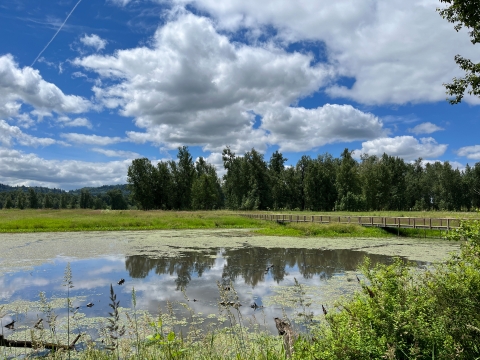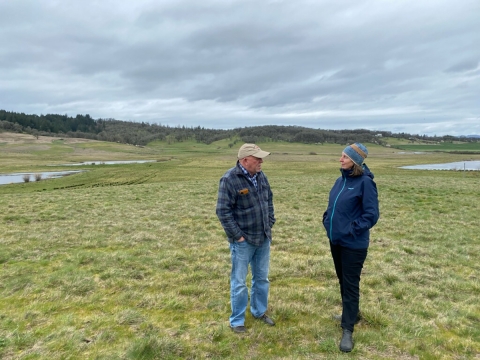What We Do
Headquartered in Portland, Oregon, the region is dominated by public lands and waters. Diverse populations, Tribes with treaty rights, Native Hawaiians, Indigenous Pacific Islanders, and other passionate stakeholders are just a few of the communities we serve.
Our region is home to the life-giving Columbia River, awe-inspiring mountain ranges, and fiery volcanoes. It has diverse ecosystems, including high mountain desert, alpine meadows, tropical forests, coral reefs, and the deepest oceanic trench on the planet.
In the Pacific Region, there are:
- More than 750 million acres of public lands and waters
- 73 National Wildlife Refuges and one waterfowl production area waterfowl production area
Waterfowl production areas are small natural wetlands and grasslands within the National Wildlife Refuge System that provide breeding, resting and nesting habitat for millions of waterfowl, shorebirds, grassland birds and other wildlife. Virtually all waterfowl production areas are in the Prairie Pothole Region states of Iowa, Minnesota, Montana, North Dakota and South Dakota.
Learn more about waterfowl production area , totaling more than 3.5 million acres - 5 National Monuments
- 620 species of migratory birds
Our region is responsible for more than 1,154,710 square miles of public lands, and more endangered and threatened species than any other region in the nation.
National wildlife refuges form the backbone of the four Marine National Monuments in the Pacific Islands. Together, they protect 756,478,592 acres of public lands and waters. From vital seabird colonies to essential deep ocean habitat, they help keep our oceans healthy and thriving.
We manage a network of 40 fisheries field stations in Idaho, Oregon and Washington. These fisheries prove more than 50 million steelhead and salmon each year to support the Pacific Salmon Treaty and $2.8 billion in commercial, recreational, and Tribal harvest.
Stewardship of our land and water resources in the Pacific Northwest is deeply interwoven with the culture, heritage, and historical practices of Native American Tribes. There are 46 federally recognized Tribes in our region, many with treaty rights to manage and harvest fish and wildlife resources.
Management and Conservation
One plus one never equals three--except in the world of partnerships. When people work together to accomplish what they cannot do alone, this equation makes sense.
Our region works with states, Tribes, private landowners, industry, non-governmental organizations, wildlife rehabilitators, and other federal agencies to accomplish our mission. Together, we do more.
- Partnerships such as the Pacific Lamprey Conservation Initiative bring together states, Tribes, and other federal partners to lead the way in conservation of species of subsistence and spiritual importance to Tribes. Warm Springs National Fish Hatchery, located on the Warm Springs Indian Reservation, is the first National Fish Hatchery to install Pacific lamprey passage.
- In Hawaiʻi, the Snail Extinction Protection Program and the Plant Extinction Prevention Program are unique partnerships that together protect almost 300 species listed as threatened or endangered. These programs collect for storage and propagation, protect current populations and key habitats, and help establish additional populations, reducing the risk of extinction.
- In Papahānaumokuākea Marine National Monument, we are working with the State of Hawaiʻi, NOAA, Office of Hawaiian Affairs, Pacific Rim Conservation, and other partners to translocate at-risk seabirds to James Campbell National Wildlife Refuge on Oʻahu. Establishing colonies on higher islands helps build resiliency into the population, hopefully preventing the species from needing to be listed.
- Across the Pacific, we help connect our work with natural and cultural history. At Litekyan, an ancient CHamoru village protected within the boundaries of Guam National Wildlife Refuge, traditional and cultural knowledge is incorporated into education programs. At the Kalaeloa Unit of Pearl Harbor National Wildlife Refuge, community members work to restore and monitor listed anchialine shrimp pools and plant and tend over 2,000 native and listed plants.
- The Salmon Superhighway Partnership is an unprecedented effort to restore fish passage fish passage
Fish passage is the ability of fish or other aquatic species to move freely throughout their life to find food, reproduce, and complete their natural migration cycles. Millions of barriers to fish passage across the country are fragmenting habitat and leading to species declines. The U.S. Fish and Wildlife Service's National Fish Passage Program is working to reconnect watersheds to benefit both wildlife and people.
Learn more about fish passage to almost 180 miles of blocked habitat throughout six major salmon and steelhead rivers of Oregon’s North Coast. As of January 2022, the partnership is more than halfway completed with 43 projects that have reconnected 115-plus miles of spawning and rearing habitat for Chinook, coho, chum, steelhead, cutthroat trout, and lamprey, while making Tillamook County’s transportation system safer for residents, visitors, and industry.
Our Projects and Research
Collaboration is the key to our success in recovering imperiled wildlife. The Service works closely with diverse partners toward delisting and downlisting species. We also work hard to keep species from being listed.
- A few decades ago, golden paintbrush was a rare sight within Washington and Oregon’s dwindling prairie habitats. Thanks to the collective efforts of many partners, in 2021 the Service proposed to delist the golden paintbrush due to recovery. Today, golden paintbrush is present at 48 sites totaling more than 500,000 plants, compared to only 20,000 when it was first listed in 1997.
- After 60 years of collaborative conservation efforts among federal, state, non-governmental organizations, private landowners, and local partners, the nēnē (Hawaiian goose) was downlisted from endangered to threatened. An intensive captive breeding program, habitat restoration, and active management strategies have led to the nēnē's return from the brink of extinction. Since the downlisting, the aeʻo (Hawaiian stilt) has also been proposed for downlisting thanks to collaborative conservation partnerships.
- The Oregon chub is just a little minnow living in the Willamette River Basin alongside young salmon and steelhead. But this fish is a champion of champions. Through collaboration with state, federal and NGO partners, it became the little minnow that could when it was the first fish ever removed from the Endangered Species List due to recovery. Since then, three additional fish in Oregon have been delisted due to recovery.
Our Laws and Regulations
We are fully committed to our trust and treaty obligations to Tribes, and to engaging in meaningful government-to-government consultation to conserve and protect Tribal resources.
In the Pacific Islands, natural resources are cultural resources. We are working to ensure we meet our trust responsibilities and work with Indigenous communities across the Pacific Islands to protect wildlife and plants for future generations.
In Hawaiʻi, the U.S. has a special political and trust relationship with the Native Hawaiian community, furthered by Congress through more than 150 legislative enactments. In the Pacific Island Territories and Freely Associated States, we work through unique federal and local laws and agreements with the respective governments, Indigenous peoples, and community partners.






